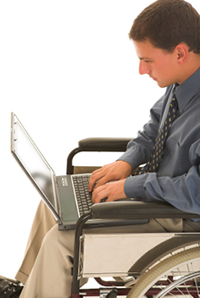 Although we often take our bodies for granted, they are not indestructible nor do they last forever. Those of us who consider ourselves “able-bodied” will find that this condition is only temporary and, at some point, whether through normal wear and tear or through injury or illness, we too will face the frustration of not being able to do the things we used to be able to do and, perhaps, the need to rely on others for assistance.
Although we often take our bodies for granted, they are not indestructible nor do they last forever. Those of us who consider ourselves “able-bodied” will find that this condition is only temporary and, at some point, whether through normal wear and tear or through injury or illness, we too will face the frustration of not being able to do the things we used to be able to do and, perhaps, the need to rely on others for assistance.
It should go without saying that we treat all people who have disabilities as we would like to be treated in a similar situation. However, if you have not yet been in a similar situation, you may feel awkward and unsure about how you would want to be treated.
The following general guidelines for interacting with or assisting people who have disabilities may help:
- Be respectful of the person’s capabilities
Most people who have disabilities have learned how to cope in most situations they encounter. Don’t assume they need help or are incapable, but if someone seems to be having difficulty, ask them if you can be of assistance.
- Ask before entering a person’s personal space
Remember that assistive devices, such as wheelchairs, canes, and service dogs, are part of the person. If someone seems to be struggling up a hill or curb in a wheelchair, ask if they would like assistance before you take hold of their wheelchair. If a person with a visual impairment is attempting to navigate a busy area, introduce yourself and ask if you can help, and then allow them to take your arm rather than taking hold of them. Always, let the person tell you the best way you can help them.
- Communicate with the person directly
Avoid talking with a person’s attendant as though the person wasn’t present. If you are speaking with a person who has a hearing impairment, face them as you talk. Avoid talking fast or using exaggeratedly slow speech and do not cover your face or mouth. People with hearing impairments often use facial expression and mouth movement to help them understand what is being said.
- When possible, talk to people at their eye level.
If you are talking to someone who is in a wheelchair, you might squat beside them or sit in a chair so they don’t have to look up at you. If you are standing, don’t stand so close that they have to tip their head all the way back to make eye contact with you.
Although there are other disability-specific suggestions, the most important thing to remember when interacting with people who have disabilities is to treat them with the same respect and consideration you would anyone else. Most people are forgiving when intentions are good so don’t avoid interacting with people who have disabilities for fear you will make a mistake. For additional information about disability etiquette, see here: United Spinal Organization Guidebook.

 Posted in
Posted in  Tags:
Tags: 